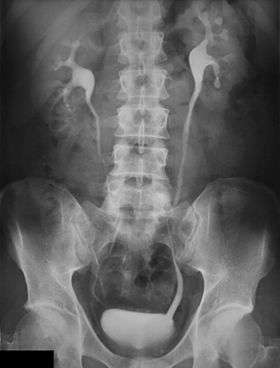Ureteral cancer
Ureteral cancer is cancer of the ureters, muscular tubes that propel urine from the kidneys to the urinary bladder. It is also known as ureter cancer,[1] renal pelvic cancer,[1] and rarely ureteric cancer or uretal cancer. Cancer in this location is rare.[1][2]
| Ureteral cancer | |
|---|---|
| Specialty | Oncology |
Ureteral cancer is usually transitional cell carcinoma.[2][3] Transitional cell carcinoma is "a common cause of ureter cancer and other urinary (renal pelvic) tract cancers."[1]
Symptoms
Symptoms of ureteral cancer may include "blood in the urine (hematuria); diminished urine stream and straining to void (caused by urethral stricture); frequent urination and increased nighttime urination (nocturia); hardening of tissue in the perineum, labia, or penis; itching; incontinence; pain during or after sexual intercourse (dyspareunia); painful urination (dysuria); recurrent urinary tract infection; urethral discharge and swelling".[4]
Risk factors
Tobacco smoking is associated with an increased risk of ureteral cancer.[5]
Diagnosis


Diagnosis may include a fluorescence in situ hybridization (FISH) test, computed tomography urography (CTU), magnetic resonance urography (MRU), intravenous pyelography (IVP) x-ray, ureteroscopy,[6] or biopsy.
Treatment
Treatment methods include surgery,[1][7] chemotherapy,[1] radiation therapy[1] and medication.[1]
Epidemiology
Between 1988 and 2001 in the United States, cancer surveillance reports to SEER included 1,333 cases of ureteral cancer in adults: 808 male and 525 female, 1,158 white and 42 black. Of the total, 1,251 (94%) were transitional cell carcinoma of the papillary type.[2] "Five-year relative survival rates from cancers of the ureter were similar among males vs. females..."[2]
See also
- Ureteral neoplasm, a type of tumor that can be primary, or associated with a metastasis from another site
- Urethral cancer, cancer of the urethra
- Urothelium, the tissue layer that lines much of the urinary tract, including the renal pelvis, the ureters, the bladder, and parts of the urethra
References
- Ureter Cancer, Mayo Clinic
- Ries, LAG; Young, JL; Keel, GE; Eisner, MP; Lin, YD; Horner, M-J, eds. (2007), "Chapter 30: Cancers of Rare Sites", SEER Survival Monograph: Cancer Survival Among Adults: US SEER Program, 1988-2001, Patient and Tumor Characteristics, SEER Program, NIH Pub. No. 07-6215, Bethesda, MD: National Cancer Institute, pp. 251–262, archived from the original on 10 October 2013, retrieved 18 October 2013
- Transitional Cell Cancer (Kidney/Ureter), National Cancer Institute
- Urethral Cancer, Department of Urology, University of Miami Leonard M. Miller School of Medicine
- McCredie M, Stewart JH, Ford JM (July 1983). "Analgesics and tobacco as risk factors for cancer of the ureter and renal pelvis". J. Urol. 130 (1): 28–30. doi:10.1016/s0022-5347(17)50936-2. PMID 6864908.
- Ureter Cancer Diagnosis, Mayo Clinic
- Ureteral Cancer, Fox Chase Cancer Center
External links
- Transitional Cell Cancer (Kidney/Ureter), National Cancer Institute